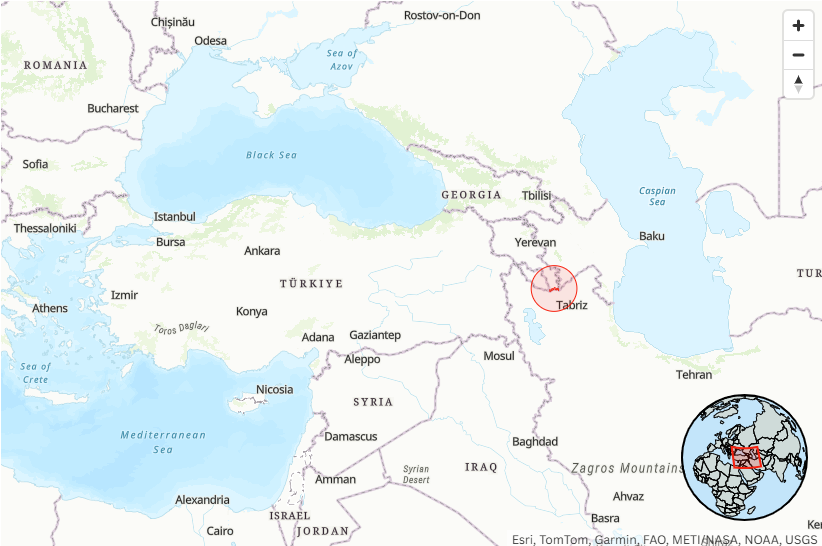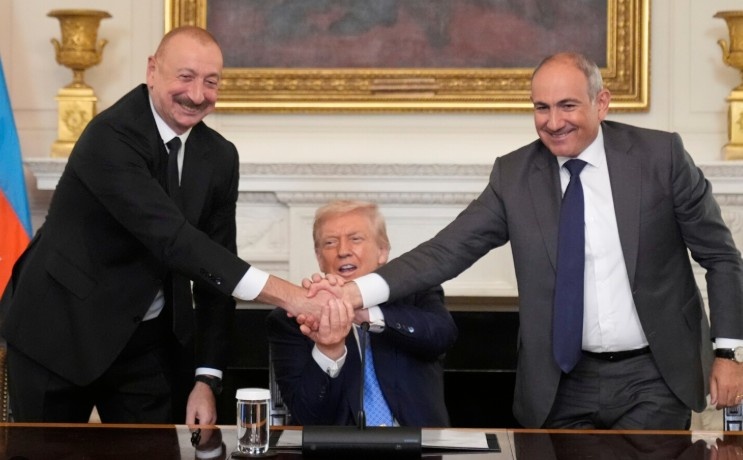Geopolitics is like a chessboard. One might take a slight lead in one part of the world, but lose tremendous leverage in another part of the world, even before it has counted its gains. While chasing one crown, another often slips from your grasp.
As Russian President Vladimir Putin heads to Alaska for a historic face-to-face meeting with his US counterpart, President Donald Trump, to discuss a Ukraine peace deal and cement his hard-fought gains in Eastern Ukraine, Trump has already pulled a geopolitical coup against Moscow in the Caucasus, another former Soviet Union territory.
The historic Azerbaijan–Armenia Peace Deal under the US aegis is a significant victory for Washington, but a setback for Moscow.
With this deal, Trump has achieved more than just burying the remnants of lingering Russian influence in Armenia and Azerbaijan (both former Soviet Republics), but killed two, rather three birds, with a single arrow.
With a single shot, Trump has aimed not only at Russia, Iran, and China, America’s three primary adversaries, but also opened a new front for US influence in a region that has been traditionally out of bounds for Washington.

With this single deal, Trump has harmed Russian interests in the Caucasus, cut off Iranian access to Europe and the Black Sea, made billions of dollars of Chinese investments in the region under the Belt and Road Initiative (BRI) dependent on a corridor financed by US capital, and established NATO right in the center of an area at the crossroads of Russia-China and Iran.
However, the single biggest takeaway from the deal could be that the US will now have a territory right on the Iran border.
The Azerbaijan–Armenia Peace Deal And The Corridor That Changes Everything
Azerbaijan and Armenia have fought bitter wars and lived under the constant shadow of hostilities for nearly four decades. The vexing Nagorno-Karabakh conflict has been compared to other unresolved issues, such as the India-Pakistan conflict over Kashmir and the Israel-Palestine conflict over Jerusalem.
Like these historic conflicts, the Azerbaijan–Armenia conflict was considered unresolvable.
However, earlier this month, the announcement of a peace deal between Azerbaijan and Armenia surprised everyone.
The deal commits both sides to end hostilities, establish full diplomatic relations, and respect each other’s territorial integrity.
The deal also clears the way for U.S. defense cooperation with Azerbaijan, suspended in light of Baku’s hostilities towards Armenia.
Most importantly, the deal establishes a 43-kilometer transit link through southern Armenia known as the “Trump Bridge” or TRIPP — the Trump Route for International Peace and Prosperity.
Known earlier as the Zangezur Corridor, the transit link connects mainland Azerbaijan to its Nakhchivan exclave, a separate part of the country southwest of Azerbaijan proper, bordered by Armenia, Iran, and Turkey.
The corridor will establish road, rail, and gas pipeline links between Azerbaijan, the Nakhchivan exclave, Turkey, and further onwards to Europe, West Asia, and Africa.
Chair of War Studies at the Madison Policy Forum, John Spencer, writes: “TRIPP is expected to unlock an estimated 45 billion dollars in energy and infrastructure opportunities by creating a secure, continuous route for pipelines, freight rail, and fiber-optic networks that physically link Europe, Asia, and the Middle East.”
“For Azerbaijan, it is a decisive change. Oil, natural gas, refined products, and goods can move directly west into Turkey without passing through Georgia or Iran…For Armenia, the corridor promises infrastructure investment, new trade flows, and economic integration after years of isolation,” Spencer added.

The US wins exclusive special development rights to the Zangezur Corridor land for 99 years.
For Turkey, the deal cements its geostrategic status as a vital link for establishing trade, energy, and logistics linkages between Europe, West Asia, Africa, and Asia. The deal further supports Turkey’s assertion that no North-South, or East-West trade route is possible by excluding Ankara.
However, as the saying goes, “One man’s deal seals another’s defeat,” the agreement is a geopolitical defeat for the Russia-China-Iran axis.
The Azerbaijan–Armenia Deal Impact On Russia-China-Iran Axis
Both Azerbaijan and Armenia are former Soviet states. Russia considers all former Soviet republics as part of Russkiy Mir (Russian world) and is opposed to any Western interference in these states.
Additionally, Armenia is also part of the Commonwealth of Independent States (CIS), a Russia-led security alliance of former Soviet republics, considered Moscow’s answer to NATO, as it also carries a clause of collective security.
Russia has historically negotiated ceasefire agreements between Armenia and Azerbaijan, including during 2020, 2022, and 2023 wars.
However, the two countries signing a peace agreement negotiated and backed by the US underline Russia’s declining influence in the Caucasus as Moscow remains occupied with the Ukraine War.
Russia, which still has a military base in Armenia, seems unable to stop Yerevan’s decisive tilt towards Europe and the West.
The deal also sidesteps Moscow’s ability to control Caucasus trade and energy routes by creating a US-brokered, Turkey-linked pathway that operates outside Russian influence.
Similarly, the corridor bypasses Iranian territory entirely, cutting Tehran out of valuable transit revenues and removing a significant source of Iranian political leverage over Azerbaijan.
“By reshaping how energy, goods, and information move through the region, TRIPP weakens two of Washington’s principal geopolitical rivals while reinforcing NATO’s southeastern flank,” Spencer wrote.
Iranian commentators are already describing the corridor, termed the ‘corridor of prosperity’ in the US, as “Iran’s geopolitical suffocation in the region.”
Abbas Mousavi, former Iranian ambassador to Baku and a deputy presidential spokesperson, described Trump’s direct involvement in the issue of relations between Azerbaijan and Armenia as ‘interesting, offensive, and dangerous.”
Furthermore, Washington’s involvement in the corridor places the US right on Iran’s northern border. Tehran fears the deal will cut it out of a lucrative trade route, will cut its access to the Black Sea and further to Europe through Georgia, and might place US troops and military infrastructure right on Iran’s border.
A senior adviser to Iran’s Supreme Leader Ali Khamenei warned that Tehran would turn the area into “a graveyard of the mercenaries of Donald Trump.”
Iran also warned that the deal would place NATO right between Iran and Russia.
Velayati, Khamenei’s adviser, warned that NATO members, including Turkey, were seeking a greater presence in the region, too. “NATO wants to lie between Iran and Russia like a viper, but Iran will not permit it.”
Amid fears of Russia cutting a deal with Trump for reaching a favorable settlement in Ukraine, Velayati warned that Iran would act “with or without Russia” to protect its interests.
The corridor is also a setback to China, which has invested billions of dollars in the region under its BRI initiative. However, Beijing will now become critically dependent on a US-funded and maintained corridor for access to this route, which is touted as the ‘Middle Corridor’ for trade between Asia and Europe.
For now, it seems that the US has scored a decisive geopolitical victory in the Caucasus. However, geopolitics is a long game where friends can turn foes in an instant. It remains to be seen whether the deal will establish long-lasting peace between Armenia and Azerbaijan, and how the Russia-China-Iran axis responds to these developments.
- Sumit Ahlawat has over a decade of experience in news media. He has worked with Press Trust of India, Times Now, Zee News, Economic Times, and Microsoft News. He holds a Master’s Degree in International Media and Modern History from the University of Sheffield, UK.
- VIEWS PERSONAL OF THE AUTHOR.
- He can be reached at ahlawat.sumit85 (at) gmail.com



